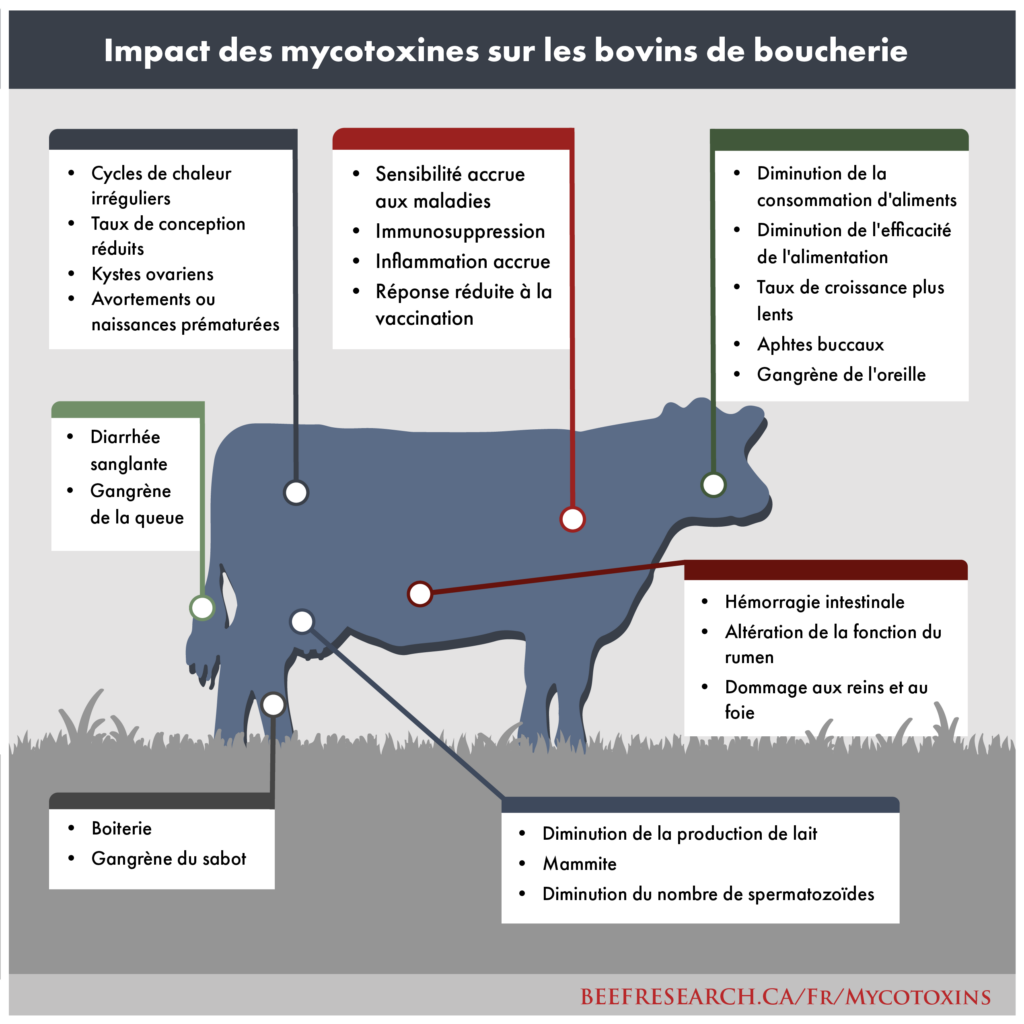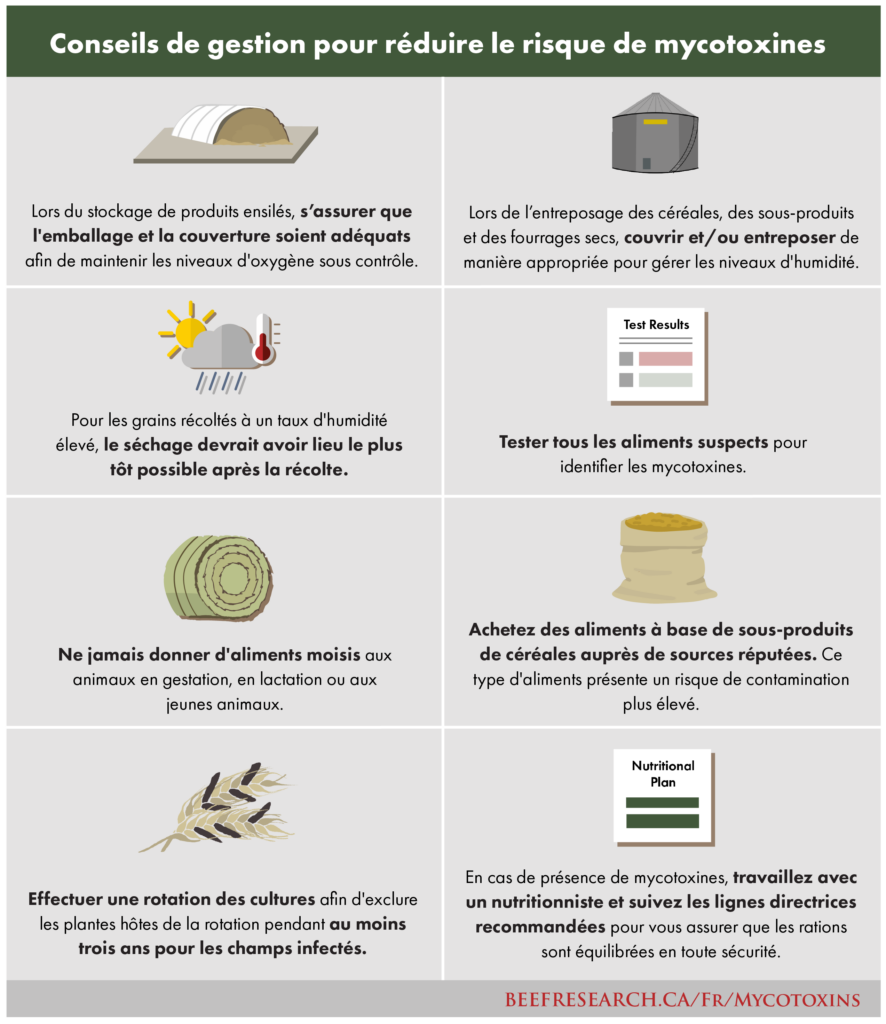Dangers cachés - Le défi des mycotoxines dans l'alimentation des bovins de boucherie

Les mycotoxines sont souvent des dangers cachés dans l’alimentation des bovins et peuvent créer toute une série de problèmes, dont une réponse immunitaire déficiente qui peut entraîner des infections secondaires, des taux de croissance compromis, des performances de reproduction réduites, la boiterie et la gangrène. Les maladies causées par les mycotoxines peuvent être difficiles à identifier et les traitements antibiotiques n’ont que peu ou pas d’effet. Par conséquent, il est essentiel de connaître la menace que représentent les mycotoxines et les mesures de prévention appropriées à mettre en œuvre pour réduire le risque pour les bovins.
Que sont les mycotoxines ?
Les mycotoxines sont produites par certains types de champignons, dont les moisissures, et peuvent être présentes dans pratiquement tous les fourrages et autres aliments pour animaux consommés par les bovins. Le fait que des moisissures ou des corps d’ergot ne soient pas visibles dans le fourrage, les céréales ou les criblures ne garantit pas l’absence de mycotoxines. Ces toxines sont invisibles, incolores et inodores. En outre, la présence de plusieurs mycotoxines dans un même aliment peut avoir un impact négatif accru sur l’animal.
Les sources les plus courantes de mycotoxines auxquelles sont confrontés les producteurs de bœuf canadiens sont les maladies fongiques telles que le Fusarium et l’ergot, ainsi que les problèmes environnementaux, de manipulation et d’entreposage qui contribuent à la formation de moisissures dans les aliments pour animaux. Le risque de présence de mycotoxines en concentrations élevées dans les aliments pour bovins peut fluctuer considérablement d’une année à l’autre.

Quand les mycotoxines représentent-elles le plus grand risque ?
- Si l’on soupçonne que les aliments sont contaminés ou si les conditions ont été favorables à la production de mycotoxines
- Lorsque des moisissures sont visiblement présentes dans un aliment destiné aux bovins et que cet aliment constitue une grande partie du régime alimentaire
- Si des changements significatifs dans les performances de production ou la santé sont observés dans un grand pourcentage du troupeau
- Si les baisses de performance ou de santé n’ont pas de cause évidente
Quels sont les signes de toxicité des mycotoxines chez les bovins de boucherie?
Les symptômes de la toxicité des mycotoxines varient en fonction des toxines présentes, de la quantité ingérée, de la durée d’exposition, de l’état de l’animal et du stade de production. Ces symptômes peuvent être les suivants :
- Une réduction de l’ingestion d’aliments : une réduction de l’ingestion d’aliments de plus de 30 % doit être examinée
- Diminution de la croissance ou de la performance, ou incapacité à se développer
- L’animal semble fréquemment malade, ce qui peut indiquer une suppression immunitaire
- L’animal ne réagit pas au traitement antibiotique
- L’animal présente des convulsions, des spasmes musculaires ou une paralysie temporaire
- L’animal présente une gangrène ou une boiterie, surtout au niveau des oreilles, de la queue et des pieds, ce qui est un signe de toxicité de l’ergot
- L’animal présente des signes de stress thermique, un rythme respiratoire accéléré, des halètements ou de la bave
- L’animal a de la fièvre ou une diarrhée intermittente et sanglante
- La bouche présente des cloques, des rougeurs ou des ulcères
- Avortements et naissances prématurées, ou diminution de la lactation

Que pouvez-vous faire pour protéger votre bétail ?
La réduction du risque lié aux mycotoxines se résume à quatre facteurs :
- la sensibilisation
- l’analyse des aliments pour animaux
- meilleures pratiques supplémentaires pour la qualité des aliments
- meilleures pratiques pour maintenir les animaux en bonne santé
Surveillez les facteurs de risque qui peuvent fluctuer d’une saison à l’autre et d’une année à l’autre, et qui sont fortement influencés par les conditions d’humidité pendant la croissance, la récolte et le stockage. Par exemple, le risque de production de Fusarium augmente en présence de conditions chaudes et humides pendant la floraison. En revanche, l’ergot préfère les conditions fraîches et humides à ce stade.
Lorsque les producteurs cultivent leurs propres aliments pour animaux, la surveillance des maladies doit inclure l’année précédente, car les conditions de risque et la présence de pathogènes peuvent se reporter d’une année à l’autre. Dans le cas de l’ergot, si les corps fongiques sont laissés à maturité, ils se détachent de la tête de la plante et tombent sur le sol, recommençant ainsi le cycle. Si les risques sont élevés, il convient d’envisager l’ensilage de la récolte ou la coupe précoce pour le fourrage vert avant que les corps d’ergot ne se développent. Pour les graminées utilisées pour l’alimentation animale qui peuvent être infectées, il est préférable de les faucher le plus tôt possible.
Effectuez régulièrement des tests sur tous les aliments soupçonnés d’être contaminés. N’oubliez pas que les mycotoxines et les moisissures ne sont pas la même chose. Des mycotoxines peuvent être présentes dans un aliment même si aucune moisissure n’est visible. Il est donc difficile d’établir une corrélation entre les moisissures ou les grains endommagés et la présence de mycotoxines. Le seul moyen d’en avoir le cœur net est de procéder à des analyses d’aliments pour animaux afin d’identifier les mycotoxines.
Pour garantir des aliments de haute qualité, il faut également respecter les meilleures pratiques en matière de qualité des aliments lors de la récolte, de l’entreposage et de la distribution. Il s’agit notamment d’emballer correctement les aliments ensilés pour garantir l’exclusion de l’oxygène, de gérer les niveaux d’humidité pour les céréales, les sous-produits et les fourrages secs, et d’acheter des aliments à base de sous-produits auprès de sources réputées, car ce type d’aliments présente un risque accru de contamination.
Les animaux en bonne santé qui ne sont pas exposés à des facteurs de stress sont moins sensibles à l’impact de nombreuses mycotoxines. Suivez les meilleures pratiques en matière de vaccination, de lutte contre les parasites internes et externes, de biosécurité, de manipulation à faible stress, de nutrition et de santé intestinale.
Il est pratiquement impossible d’éliminer la menace des mycotoxines. Toutefois, les producteurs peuvent prendre des mesures préventives pour réduire le risque de contamination de leurs sources d’alimentation par les mycotoxines. Si des mycotoxines sont détectées dans des aliments pour animaux, certaines stratégies peuvent être suivies pour rendre la source d’alimentation plus sûre pour les bovins.
Le partage ou la réimpression des publications du BCRC sont les bienvenus et sont encouragés. Veuillez mentionner le Beef Cattle Research Council, fournir l’adresse du site Web, www.BeefResearch.ca, et nous faire savoir que vous avez choisi de partager l’article en nous envoyant un courriel à info@beefresearch.ca.
Vos questions, commentaires et suggestions sont les bienvenus. Contactez-nous directement ou lancez une discussion publique en publiant vos idées ci-dessous.
